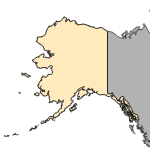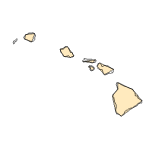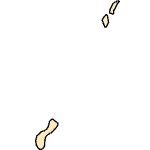Clarias gariepinus
(Sharptooth catfish)
Fishes
Exotic |
|
Common name: Sharptooth catfish
Synonyms and Other Names: Clarias lazera Valenciennes in Cuvier and Valenciennes, 1840; North African catfish, African catfish
Taxonomy: available through
www.itis.gov
Identification: Members of Clarias are distinguishable from all other North American catfishes by the absense of a dorsal fin spine and adipose fin, and presence of long dorsal and anal fins that extend nearly to, but are separate from, the caudal fin. Clarias gariepinus can be distinguished from other species of Clarias by an elevated number (24-110, depending on size) of long, thin gill rakers on the first gill arch (Teugels 1986).
Size: Maximum size is 700 mm total length, although specimens up to 1.5 m have been reported (Teugels et al. 2007).
Native Range: Africa, nearly pan-African in distribution; Israel, Syria, southern Turkey (Teugels 1986).



|

Alaska |

Hawaii |

Puerto Rico &
Virgin Islands |

Guam Saipan |
Hydrologic Unit Codes (HUCs) Explained
Interactive maps: Point Distribution Maps
Nonindigenous Occurrences:
Two specimens were collected from the Canal de Patillas in Guayama, Puerto Rico, in October 2018 (Rodriguez-Barreras and Zapata-Arroyo 2019).
Table 1. States with nonindigenous occurrences, the earliest and latest observations in each state, and the tally and names of HUCs with observations†. Names and dates are hyperlinked to their relevant specimen records. The list of references for all nonindigenous occurrences of Clarias gariepinus are found here.
Table last updated 12/14/2025
† Populations may not be currently present.
Ecology: Inhabits lake, river, and shallow floodplain environments. Extremely varied omnivorous diet, comprising zooplankton, benthic invertebrates, and fishes with incidental consumption of detritus, filamentous algae, and macrophytes (Spataru et al. 1987, Winemiller and Kelso-Winemiller 1996, Dadebo 2009, Dadebo et al. 2014). Breeding within the native range generally occurs during rainy season (Dadebo 2000).
Means of Introduction: Unknown; potential pathways include aquarium release and escape from aquaculture ponds (Rodriguez-Barreras and Zapata-Arroyo 2019). Widely introduced around the world primarily for aquaculture (FAO 2010, Weyl et al. 2016).
Status: Unknown.
Impact of Introduction: The impacts of this species are currently unknown, as no studies have been done to determine how it has affected ecosystems in the invaded range in the US and associated territories. The absence of data does not equate to lack of effects. It does, however, mean that research is required to evaluate effects before conclusions can be made. Worldwide, there has been limited direct research on impacts to ecosystems invaded by C. gariepinus. Most impacts to native communities have been inferred from presence of native species (e.g., fishes) in diet studies, although there is limited experimental evidence that C. gariepinus can alter invertebrate community composition (reviewed by Weyl et al. 2016).
References: (click for full references)
Dadebo, E. 2000. Reproductive biology and feeding habits of the catfish
Clarias gariepinus (Burchell) (Pisces: Clariidae) in Lake Awassa, Ethiopia. SINET: Ethiopian Journal of Science 23(2):231-246.
https://www.ajol.info/index.php/sinet/article/view/18168 Dadebo, E. 2009. Filter-feeding habit of the African catfish Clarias gariepinus Burchell, 1822 (Pisces: Clariidae) in Lake Chamo, Ethiopia. Ethiopian Journal of Biological Sciences 8(1):15-30. https://www.ajol.info/index.php/ejbs/article/view/89769
Dadebo, E., D. Aemro, and Y. Tekle-Giorgis. 2014. Food and feeding habits of the African catfish Clarias gariepinus (Burchell, 1822) (Pisces: Clariidae) in Lake Koka, Ethiopia. African Journal of Ecology 52(4):471-478. https://www.onlinelibrary.wiley.com/doi/abs/10.1111/aje.12146
FAO. 2010. Cultured aquatic species information programme: Clarias gariepinus (Burchell, 1822). http://www.fao.org/fishery/culturedspecies/Clarias_gariepinus/en. Created on 01/01/2010. Accessed on 02/07/2019.
Rodriguez-Barreras, R., and C. Zapata-Arroyo. 2019. The first record of the African catfish Clarias gariepinus (Burchell, 1822) in Puerto Rico. International Journal of Aquatic Sciences 10(2):98-100. http://www.journal-aquaticscience.com/article_81042.html
Spataru, P., W.J.A.R. Viveen, and M. Gophen. 1987. Food composition of Clarias gariepinus (= C. lazera) (Cypriniformes, Clariidae) in Lake Kinneret (Israel). Hydrobiologia 144:77-82. https://link.springer.com/article/10.1007/BF00008053
Teugels, G.G. 1986. A systematic revision of the African species of the genus Clarias (Pisces; Clariidae). Annales Du Musée Royale de l'Afrique Centrale (série Zoologie) 247:1-199.
Teugels, G.G., D. Adriaens, S. Devaere, and T. Musschoot. 2007. Clariidae. Pages 653-691 in Stiassny, M.L.J., G.G. Teugels, and C.D. Hopkins, eds. The fresh and brackish water fishes of lower Guinea, west-central Africa. Volume 1. IRD Éditions. Paris, France.
Weyl, O.L.F., V.S. Daga, B.R. Ellender, and J.R.S. Vitule. 2016. A review of Clarias gariepinus in Brazil and South Africa. Journal of Fish Biology 89:386-402. https://www.onlinelibrary.wiley.com/doi/10.1111/jfb.12958
Winemiller, K.O., and L.C. Kelso-Winemiller. 1996. Comparative ecology of catfishes of the Upper Zambezi River floodplain. Journal of Fish Biology 49:1043-1061. https://onlinelibrary.wiley.com/doi/abs/10.1111/j.1095-8649.1996.tb01777.x
FishBase Summary
Author:
Neilson, M.E.
Revision Date: 10/2/2019
Citation Information:
Neilson, M.E., 2025, Clarias gariepinus (Burchell, 1822): U.S. Geological Survey, Nonindigenous Aquatic Species Database, Gainesville, FL, https://nas.er.usgs.gov/queries/FactSheet.aspx?SpeciesID=3257, Revision Date: 10/2/2019, Access Date: 12/14/2025
This information is preliminary or provisional and is subject to revision. It is being provided to meet the need for timely best science. The information has not received final approval by the U.S. Geological Survey (USGS) and is provided on the condition that neither the USGS nor the U.S. Government shall be held liable for any damages resulting from the authorized or unauthorized use of the information.